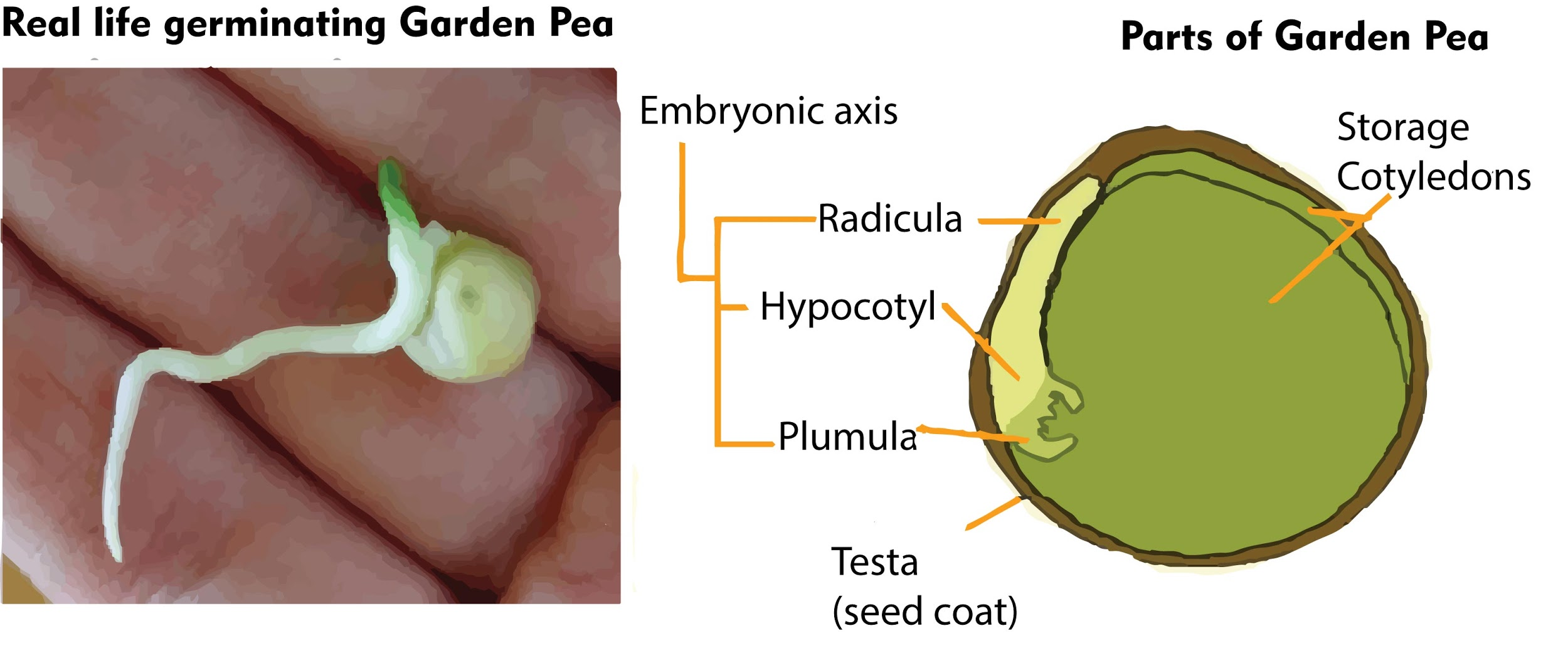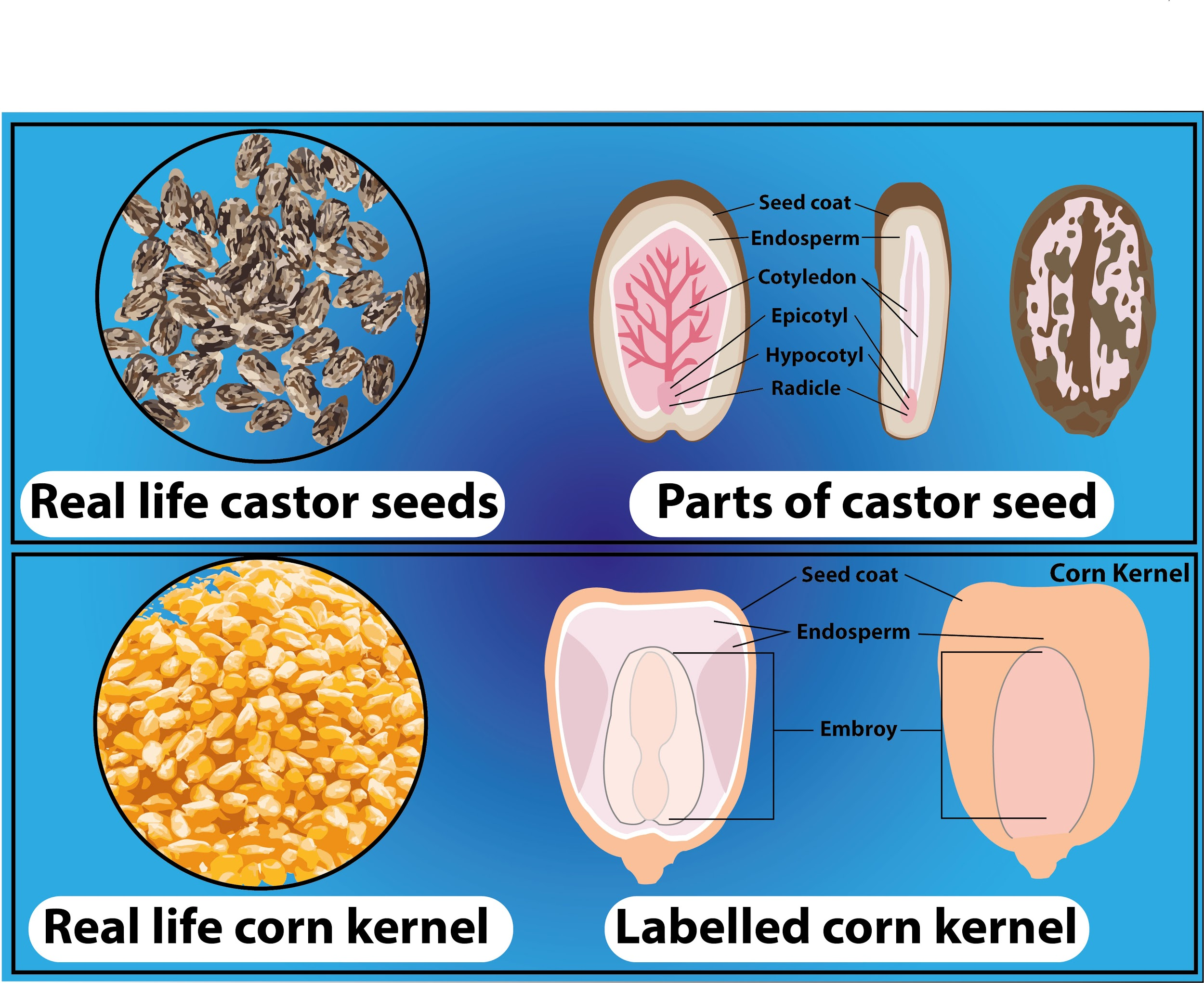
In pea, caster, and maize the number of cotyledons respectively
(a) One, two, and two
(b) Two, two and one
(c) Two, one, and two
(d) One, two, and one
Answer
576.3k+ views
Hint: A cotyledon is a type of embryonic leaf found in seed-bearing plants, one or more of it is likely to be the first leaves to appear from a germinating seed. Pea and castor bear the same number of cotyledons.
Complete answer:
The seeds of both peas and castor are dicots while maize seeds are monocots. Within the seed of a plant, a cotyledon is a significant part of the embryo. It is defined as the embryonic leaf in seed-bearing plants. One or more of the cotyledons are the first to appear from a germinating seed. Based on the number of cotyledons, botanists classify flowering plants (angiosperms) into :
a) plants with one embryonic leaf, termed monocotyledonous (monocots).
b) plants with two embryonic leaves, termed dicotyledonous (dicots).
Additional Information:
-In monocots, the cotyledon is called a scutellum which is directly connected to the embryo via vascular tissues xylem and phloem. Food reserves are stored in the large endosperm. Similarly in the dicots, the two cotyledons also have vascular connections to the embryo. In endospermic dicots, for example, tomato and pepper, the food reserves are stored in the endosperm.
- In non-endospermic dicots, for example, split pea and peanuts, the triploid endosperm develops normally following double fertilization.
So, the correct answer is ‘,Two, two and one’.
Note:
-In the case of dicot seedlings with photosynthetic cotyledons, they are functionally similar to leaves. Although, true leaves and cotyledons are distinct based on their development. During embryogenesis, cotyledons are formed along with the root and shoot meristems. They are thus present in the seed before germination.
-True leaves are formed after germination from the shoot apical meristem. It is also responsible for generating subsequent aerial portions of the plant.


Complete answer:
The seeds of both peas and castor are dicots while maize seeds are monocots. Within the seed of a plant, a cotyledon is a significant part of the embryo. It is defined as the embryonic leaf in seed-bearing plants. One or more of the cotyledons are the first to appear from a germinating seed. Based on the number of cotyledons, botanists classify flowering plants (angiosperms) into :
a) plants with one embryonic leaf, termed monocotyledonous (monocots).
b) plants with two embryonic leaves, termed dicotyledonous (dicots).
Additional Information:
-In monocots, the cotyledon is called a scutellum which is directly connected to the embryo via vascular tissues xylem and phloem. Food reserves are stored in the large endosperm. Similarly in the dicots, the two cotyledons also have vascular connections to the embryo. In endospermic dicots, for example, tomato and pepper, the food reserves are stored in the endosperm.
- In non-endospermic dicots, for example, split pea and peanuts, the triploid endosperm develops normally following double fertilization.
So, the correct answer is ‘,Two, two and one’.
Note:
-In the case of dicot seedlings with photosynthetic cotyledons, they are functionally similar to leaves. Although, true leaves and cotyledons are distinct based on their development. During embryogenesis, cotyledons are formed along with the root and shoot meristems. They are thus present in the seed before germination.
-True leaves are formed after germination from the shoot apical meristem. It is also responsible for generating subsequent aerial portions of the plant.


Recently Updated Pages
Master Class 12 Business Studies: Engaging Questions & Answers for Success

Master Class 12 Economics: Engaging Questions & Answers for Success

Master Class 12 English: Engaging Questions & Answers for Success

Master Class 12 Maths: Engaging Questions & Answers for Success

Master Class 12 Social Science: Engaging Questions & Answers for Success

Master Class 12 Chemistry: Engaging Questions & Answers for Success

Trending doubts
What is meant by exothermic and endothermic reactions class 11 chemistry CBSE

Which animal has three hearts class 11 biology CBSE

10 examples of friction in our daily life

One Metric ton is equal to kg A 10000 B 1000 C 100 class 11 physics CBSE

1 Quintal is equal to a 110 kg b 10 kg c 100kg d 1000 class 11 physics CBSE

Difference Between Prokaryotic Cells and Eukaryotic Cells




